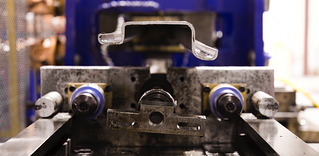 Roll forming can seem like an overwhelming process to design for, if you’re used to stamping, press braking, extrusions or other techniques. The truth is, it can actually open up new doors to creativity—and cost savings.
Roll forming can seem like an overwhelming process to design for, if you’re used to stamping, press braking, extrusions or other techniques. The truth is, it can actually open up new doors to creativity—and cost savings.
Designing for roll forming is ideal for lengthy products, parts with complex geometry, redesigns, secondary operations and more. When utilized properly, this technique can be significantly cost-effective. It’s worth considering.
Engineers: Read on to find out if roll forming is the most effective solution for your next metal fabrication design.
Complex Geometry
If you’re designing a part that has many bends, press braking can be costly and difficult, if not impossible to do. Through roll forming, however, your part can be bent to produce symmetrical or non-symmetrical cross sections. Blind corner radii can be formed very easily with roll forming, whereas this process is difficult for press braking to handle. Roll form tooling can be custom created for your unique specifications, or selected from your custom roll formers catalog. This allows you to effectively utilize supplier tooling and equipment for efficiency and cost-effectiveness.
Secondary Operations
Roll forming allows you to perform secondary operations such as in-line punching and notching during the roll form process without stopping or starting, resulting in reduced labor costs. In-line punching and notching is also programmable, thus saving tooling costs. Without the need for secondary production time, you can cut time-to-market and produce efficient designs.
Lengthy Parts
The roll forming process does not have part length restrictions. Typically, the longest length is one that can be shipped, approximately 50 feet long. This allows you ample flexibility to design within the capabilities of your suppliers’ machinery because there are fewer length limits. Further, you can eliminate the need to combine several shorter parts, in the case of long product applications. With processes like extrusions and stamping, lengthy parts can be more costly to produce and the length is more often restricted.
Material Options
Roll forming is capable of shaping materials from copper, to aluminum, to stainless steel, to ultra high-strength steels. High strength steels allow cost savings on material weight when calculating the section modulus on various sections, whereas processes like extrusions typically can handle aluminum or other soft metals.
With a range of material handling capabilities, you can cut costs on your design while retaining the same effectiveness. Many aluminum-extruded products can be redesigned for roll forming using a stronger metal at a lower gauge. This will reduce your material need while attaining the same strength.
When to Roll Form
There are certain circumstances when designing for roll forming doesn’t make sense economically. If you are designing for smaller production, less than 5000 feet per run, or if lengths are shorter than 6 inches, this may not be the option for your needs.
However, if you are designing for lengthy, complex or high production parts, roll forming is your most cost-effective, efficient solution. If you’re new to roll forming, or are looking for new design ideas to save you time and money, download the Standard Profile Engineering Guide below. This guide gives you free access to nine different roll form profiles utilizing the tooling in-house at Hynes.
Image Source: Hynes Industries

